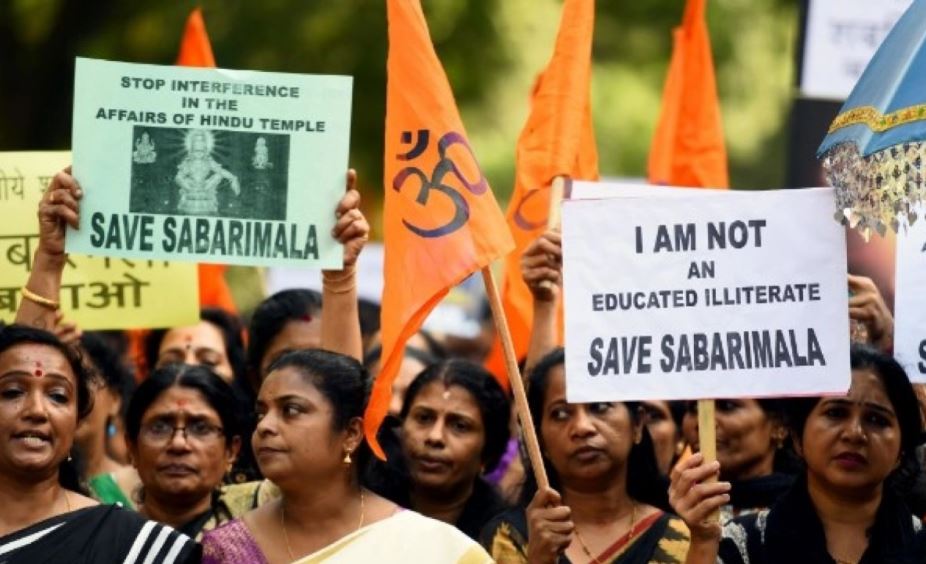In a major turn of events, a five-judge bench of the Supreme Court led by CJI Ranjan Gogoi has by a narrow 3:2 majority, referred the Sabarimala review petition to a larger bench consisting of seven judges. Last year, the Supreme Court had lifted a ban upon the entry of women, within the age group of 10 to 50 years, to enter the Sabarimala shrine. The verdict allowing women of all ages to enter the shrine was passed by a 4:1 majority. Justice Indu Malhotra had in her sole dissenting opinion observed that matters of faith could not be directed by Courts.
While deciding to refer the verdict lifting age restrictions on the entry of women into the Sabarimala shrine to a larger bench, the apex court observed that the verdict pronounced last year may impinge on the affairs of other religions as well and therefore require a more detailed examination.
The larger bench to which the review petitions in the Sabarimala case has been referred will not only hear the Sabarimala issue but will also decide the question whether any religion can impose a ban upon the entry of women to enter places of worship. The Court has clubbed two specific cases- a petition by two Parsi women married to non-Parsis to enter the Tower of Silence and a plea seeking entry of women into Mosques.
Moreover, the seven-judge bench will also decide upon the “essential religious practice” doctrine, a judicially evolved test whereby the Court decides which practice is essential and integral to religion. The Court protects only the essential religious practices. Now, the larger bench will decide whether the Courts should get into what is an essential religious practice to decide if such practice is valid, or the Courts should take a practice as essential and then proceed in accordance with the constitutional provisions.
What this virtually means is that the Sabarimala verdict will be essentially heard afresh.
The position of law that the apex court now takes will have far-reaching consequences in the Sabarimala issue. The most immediate and important implication of the apex court’s decision to refer the matter to a seven-judge bench is that it comes as a ray of hope for the Bhagwan Ayyappa devotees. The devotees who had protested in large numbers against the entry of women in the age group of 10 to 50 years. They had contended that the restriction was not in the form of discrimination, rather it was supposed to protect the celibate status of the deity, that is, Bhagwan Ayyappa. The decision to refer the matter to a larger bench is being largely seen as a foot in the door for the devotees to get the majority verdict pronounced last year potentially overturned.
With a Seven judge bench being formed to decide the question of entry of women of all ages into the Sabarimala shrine, the issue is once again going to come in national focus. It only goes on to show how important the issue is. It is not only going to have a significant impact upon the Indian jurisprudence but is also going to have far-reaching political consequences. The BJP gets a lot more space to push the LDF government into respecting the sentiments of the Bhagwan Ayyappa devotees. Ram Madhav, BJP National General Secretary tweeted, “Supreme Court’s decisions today are important. On Sabarimala, it didn’t uphold smaller bench order of last year. Hence Kerala govt shouldn’t precipitate the matter.”
Supreme Court's decisions today are important. On Sabarimala it didn't uphold d smaller bench order of last year. Hence Kerala govt shouldn't precipitate d matter. Rafael order too on expected lines exposing d irresponsibility of several eminences.
— Ram Madhav (@rammadhav_) November 14, 2019
What this verdict has done is that it has given an impetus to the BJP to push the ruling LDF in Kerala to a tight corner. In fact, the entire focus is now going to shift to the LDF government in Kerala, and the coalition government in Kerala consisting of left-wing parties is already on the backfoot. Describing the Supreme Court verdict on the Sabarimala shrine as “one that creates more trouble for the government”, Law Minister A K Balan has made it clear that the state government won’t provide any security and protection to any woman pilgrim going to Sabarimala. This is in sharp contrast to how the LDF government had arranged the surreptitious entry of women activists into the shrine last year. Kerala CM Pinarayi Vijayan has also said that more clarity is needed on the Supreme Court verdict. He said, “Now we understand that the SC judgment of September 28 is still in place but we are unclear about the implications. We need to understand the impact of this verdict and will seek legal opinions.” He also said that the government will need some time to understand the apex court verdict. It is clear that the activism that the LDF government had exhibited following the verdict allowing entry of women of all ages has vanished after the Supreme Court referred the review petition to a larger bench.
This is a landmark moment, not only in the Indian jurisprudence but also on the political landscape. With the entire nation now focusing on how the proceedings will go from here on, the Sabarimala issue might become a national issue of public importance in stark resemblance with the Ayodhya verdict. It also blurs, at least for the time being, the North-South divide with Hindu devotees across India taking a keen interest in the Sabarimala issue.
